Occasionally I rerun a favorite older post and this holiday weekend seemed like a good time to do it again. This one was published a little over ten years ago, on June 10, 2012. For this version I’ve changed the title, cleaned up the formatting (among other things, back then I was still putting two spaces between sentences) and edited some of the text.
In the grebe world competition starts early.
One of several Clark’s Grebe behaviors I was able to document at Bear River MBR last week was adults feeding their chicks. One or both youngsters were usually on the back of one parent while the other parent brought in fish for breakfast. They were always small or even tiny fish, to accommodate the very young chicks.
I had been shooting faster action just prior to this sequence so my settings for the first shot aren’t particularly appropriate but then I quickly adjusted.
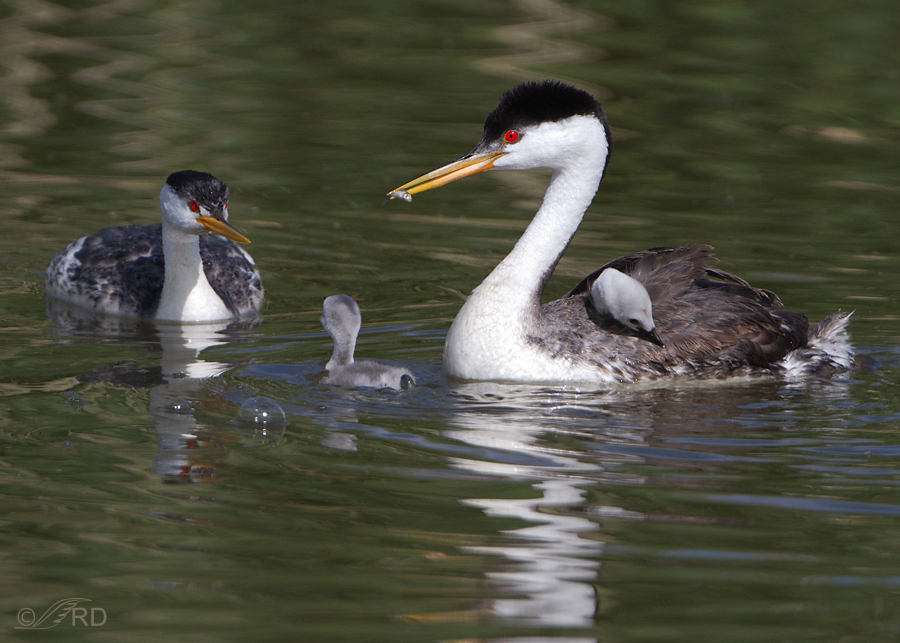
1/4000, f/6.3, ISO 640, 500 f/4, 1.4 tc
The parent bringing in the fish wouldn’t give them directly to the chicks but instead would hand them off to its mate and then that bird would feed the youngsters on its back. Here the parent on the left had just given this small fish to the brooding adult.
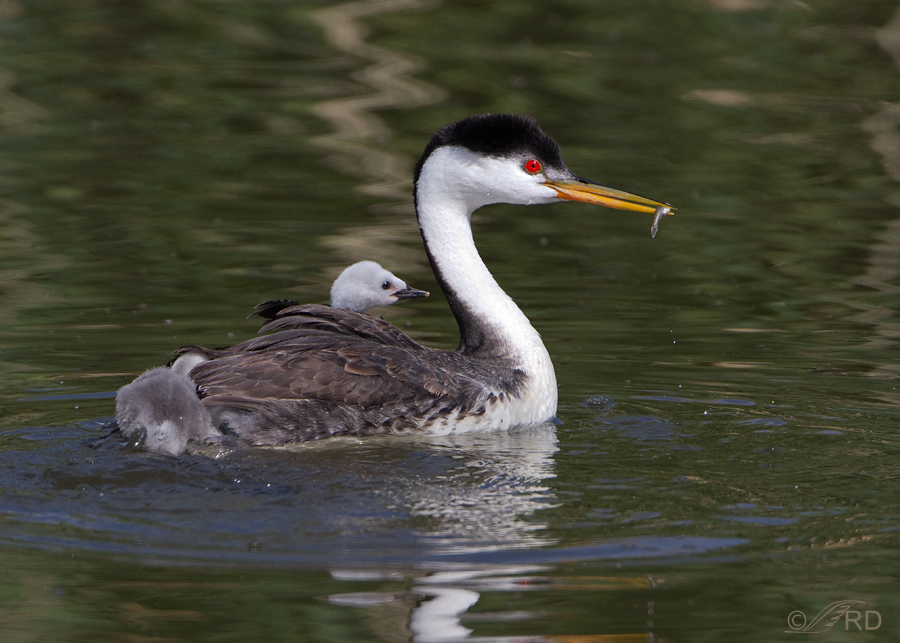
1/2500, f/8, ISO 640, 500 f/4, 1.4 tc
The chick in the water knew it had no chance to get the fish while it was there so it immediately made a beeline for the back of its parent.
When they’re this size they still struggle to get on board. Sometimes the parent sticks a leg out behind them for the chick to climb up on, but this youngster was on its own and was frantic to get up front where the food would be doled out before its sibling got the fish.
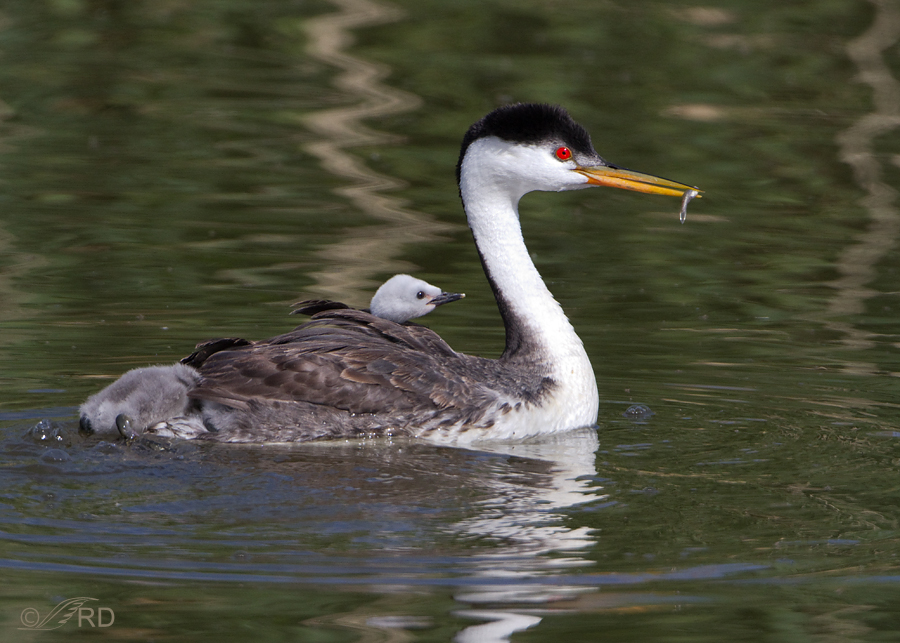
1/2500, f/8, ISO 640, 500 f/4, 1.4 tc
I imagine it’s not easy getting up there since they have to work against the grain of the feathers of the adult.
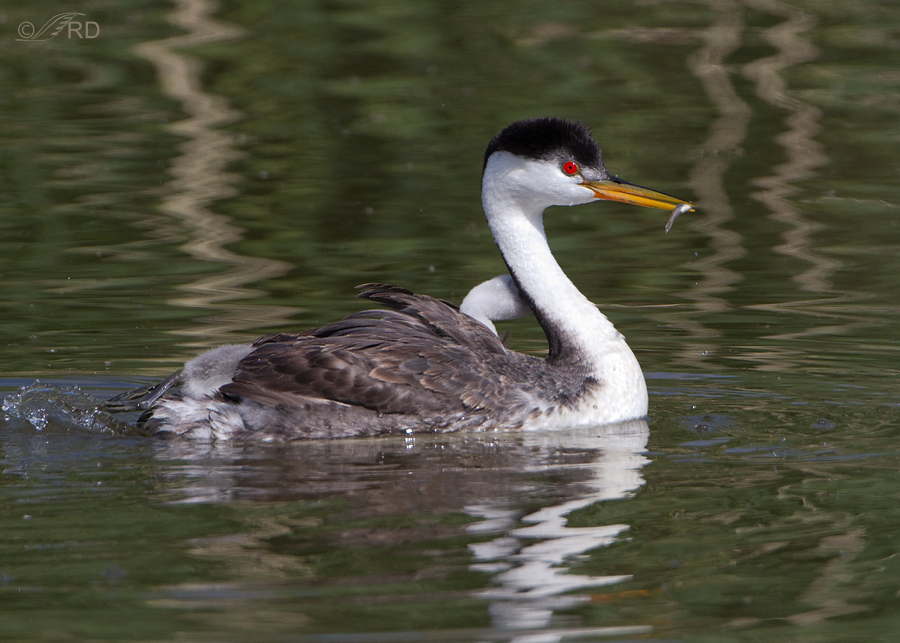
1/2500, f/8, ISO 640, 500 f/4, 1.4 tc
But this chick gave it the old college try and attempted to get up front before its sibling got the fish.
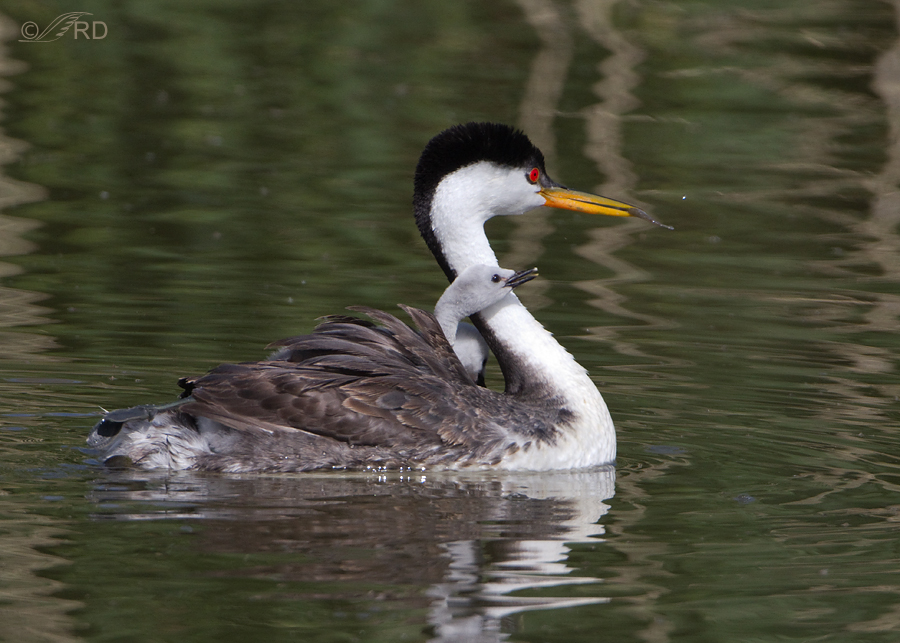
1/2500, f/8, ISO 640, 500 f/4, 1.4 tc
Here the little guy has made it – that’s “him” we can see with his sibling momentarily hidden from view. You’ll notice that his feet are still sticking out above the tail of the parent – that’s how stretched out he was in his attempt to get at the fishy prize.

1/2500, f/8, ISO 640, 500 f/4, 1.4 tc
Now the question is “who gets the fish?”

1/2000, f/8, ISO 640, 500 f/4, 1.4 tc
In the end I believe the chick that was originally in the water got it.
Sometimes the extra effort of the underdog pays off.
Ron


Super series Ron, thanks for sharing!
Charlotte Norton
Thanks, Charlotte.
Fascinating. I can imagine just how frantic the youngster in the water was and glad that it got the prize after all that effort – while hoping that the next went to the other chick. It would be very hard for the parent to keep track though I am sure that the siblings know.
Thanks, EC. They both look well fed so I suspect they each got their share over time.
Sweet series! And now, of course, I’m worried (a decade after the fact) about the poor li’l one that was “top dog” at the start who ended up with none. One hopes/assumes the parents find a way to share the wealth among their brood, else there wouldn’t be many Clark’s Grebes. Did you ever catch squabbling and scrambling among the chicks to get a morsel like that?
Thanks, Chris. I’ve certainly seen them scramble, many times, but not squabble.
I think that parent might be teasing the chicks with that morsel.
The third photo with the chick’s legs sticking out behind reminds me of your photos of Grebes trying to walk. It’s like evolution gave them a choice: swim or walk; you can do one great but the other not so much.
The chicks look like the plush toys you see in nature shops. I know, a horrible comparison. I wonder what they sound like if they get squeezed.
” It’s like evolution gave them a choice: swim or walk”
That’s pretty much it, Lyle. Watching grebes try to walk is well worth the price of admission.
Grebes are always fascinating subjects and especially endearing when youngsters are on their parents backs. Beautiful series.
Thank you, Dan.
I always enjoy your back-brooding Grebes, Ron, though I pity the shiner whose final moments are filled with the approach of that massive bill!
They’re extremely good fisherbirds, Diane.
Wow! What a fabulous series. Beautiful but it has so much more to offer. There is so much really valuable information there and so fascinating. My curiosity is energized and engaged by your careful observation.
Thanks very much, Granny Pat.
Really a pretty, educational series ! All that glitters are not raptors!
“All that glitters are not raptors!”
That’s for sure, John. But raptors certainly have their share of glitter.
These are Great Shots, love em!!
Thanks, Dick.
What a neat series Ron. Nature at its best. To the best of my knowledge I have never seen a Clark’s. If I were taking these photos I would just assume it is a Western.
“If I were taking these photos I would just assume it is a Western.”
Lots of folks make the same assumption, Everett. Notice that the blacks on the head of Clark’s Grebes don’t come down and enclose the eye. In Western Grebes they do.
Wow! This was so informative! The last picture is awesome. I hadn’t thought about how grebes and loons fed their babies so this was fascinating
Thank you, Beth.
I’m so glad that you published this again– great story with a happy ending ( for the VERY persistent chick ) and the very last photo in the series is a real
prize, in every regard, in my estimation !
I value your ‘estimation’ so thank you Kris.
Always something to learn from your posts, Ron….. 🙂 Wonder if they spread the food evenly among the chicks or it’s “whoever” at the moment? Can’t really just “drop it” and let them root around for it…. 😉
I don’t know the answer to your question, Judy. That sounds like an interesting research project for some ambitious ornithologist.
Slow motion second by second announcement of the play!! Thank you Ron, very entertaining 🙂
Good. Thanks, Terri.
I had no idea this is how they fed the chicks. Awesome sequence, thank you for sharing for the benefit of your newer fans!
Do other waterfowl feed chicks similarly?
“Do other waterfowl feed chicks similarly?”
Some but not most, Cheryl. Other grebe species, loons and a few others do (although they’re technically not “waterfowl) but most duck and goose chicks, for example, don’t. Those youngsters feed themselves.